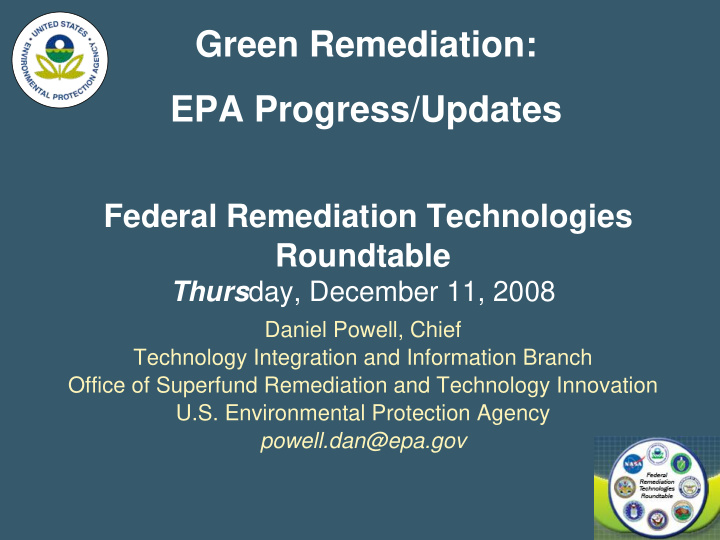



Green Remediation: EPA Progress/Updates Federal Remediation Technologies Roundtable Thurs day, December 11, 2008 Daniel Powell, Chief Technology Integration and Information Branch Office of Superfund Remediation and Technology Innovation U.S. Environmental Protection Agency powell.dan@epa.gov
What is “Green Remediation”? Green Remediation - The practice of considering all environmental effects of remedy implementation and incorporating options to maximize the net environmental benefit of cleanup actions.
Is It Our Job? • Energy Policy Act of 2005 • Energy Independence and Security Act of 2007 • Executive Order 13423 (Reducing GHG) • EPA Strategic Plan
Finding Sustainable Approaches Throughout the Land Revitalization Process Optimal Sustainable revitalization is a holistic approach to the cleanup and revitalization Sustainability of a property. It considers a broad array of Social environmental factors and community impacts during all phases (demolition, waste remediation, design and construction, reuse), in order to maximize Economic Environmental the environmental, social, and economic benefits associated with a project. Adopting green approaches is a key aspect of sustainable revitalization. Opportunities to Promote Sustainability Exist in all Phases of Land Revitalization Cleanup, Sustainable Deconstruction Design and Remediation, Use and Demolition, and Construction and Waste Long Term Removal for Reuse Management Stewardship
Opportunities to Increase Sustainability • Apply to all cleanup programs • Exist throughout site investigation, design, construction, operation, and monitoring • Address core elements
Example – Where are the Opportunities? Superfund Energy & Carbon Footprint Flash Analysis Findings 1 Remedy Estimated Total estimated Estimated CO2 Total estimated energy use energy use emissions CO2 emissions Annual Avg. 2 Annual Avg. 2008-2030 2008– 2030 (kWh*10 3 ) (kWh*10 3 ) (metric tons) (metric tons) Pump &Treat 489,607 11,260,969 323,456 7,439,480 Thermal 92,919 2,137,126 57,756 1,328,389 Desorption Multi-Phase 18,679 429,625 12,000 276,004 Extraction Air Sparging 10,156 233,599 6,499 149,476 Soil Vapor 6,734 154,890 4,700 108,094 Extraction Total 618,095 14,216,209 404,411 9,301,443
Remedy Selection vs. Remedy Implementation • Remedy Implementation-Opportunities – System design – System optimization – Capital improvements at long-term systems – Project monitoring – Effective investigation, characterization, and monitoring • Triad • Evolving Conceptual Site Model
Remedy Selection vs. Remedy Implementation • Remedy selection – Opportunities through existing selection criteria • NCP • RCRA – Policy discussions – Considerations • Balancing protectiveness with green goals • Timeframes • Perception of “green washing” • Over-reliance on energy, carbon vs. other aspects of green
Advancing Green Remediation Practices: EPA Efforts • Documenting state-of-the-art BMPs • Identifying emergent opportunities • Establishing a community of practitioners • Developing mechanisms and tools – Pilot projects for renewable energy – Technical support to project managers (“showcase sites”) – Standard contract language for cleanups – Self-auditing BMP checklists – Automated energy calculators
Advancing Green Remediation Practices: EPA Efforts • Shared efforts in tech transfer • Partnering with state and local agencies/organizations moving forward with green practices • Exploring options for a green remediation evaluation/verification system • Baseline analyses, metrics • MOUs (DOE-NERL, USACE) • Superfund Green Remediation Work Group
Superfund Green Remediation Work Group • Established in August 2008 • Includes various HQ organizations (Federal Facilities, Enforcement) and representatives from each Region • Remedy Selection vs. Implementation • Goal: Superfund strategy by June 2009 – Program implementation – Program policy and guidance – Measures/evaluation – Information resources – Communications
Green Remediation Primer • Released April 22, 2008 • Provides an introduction to GR best practices with examples of how and where they are used • Focuses on remedy implementation across regulatory frameworks • Available free online (see next slide)
Information Resources • “GR Web” cleanup profiles, technical reports, and links: www.clu-in.org/greenremediation • Technical primer, “Green Remediation: Incorporating Sustainable Environmental Practices into Remediation of Contaminated Sites”
Green Remediation Contact Information http://cluin.org/greenremediation Carlos Pachon pachon.carlos@epa.gov (703) 603-9904
Recommend
More recommend